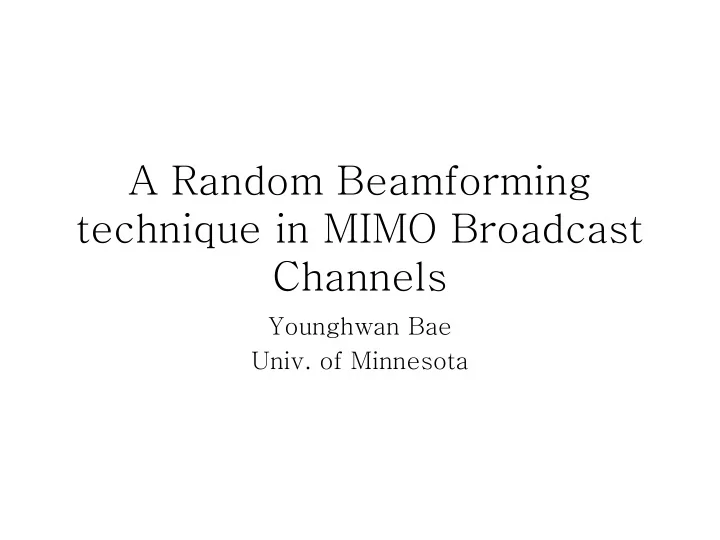

A Random Beamforming technique in MIMO Broadcast Channels Younghwan Bae Univ. of Minnesota
OUTLINE • 1. Motivation • 2. Part I. Sum Capacity of MIMO BC • 3. Part II. Simulation Results • 4. Conclusion
Motivation Both the base station and the receiver has one antenna. � Degraded broadcast channel Selecting the best user and sending data only to that user is optimal ! ‘Optimal’ means ‘maximizing the sum rate’
What if BS has more than one antenna � Non-degraded Broadcast channel Selecting only one best user is not optimal
More general case Multiple antennas at the base station Multiple antennas at each receiver � General MIMO Gaussian broadcast channel � It is not always reasonable to assume that perfect channel knowledge can be made available to the Tx.
PART I Sum Capacity
Transmitter beamforming Sub-optimal technique that supports simultaneous • transmission to multiple users on a broadcast channel Consider the interference from other users as • noise 2 P H v = = m i m K SINR , m 1, ,M + ∑ i m , M 2 1 P H v k i k ≠ k m ⎧ ⎫ M { } ( ) a ∑ + = + ≤ ⎨ ⎬ R = E log(1 SINR ) ME log(1 SINR ) i m , i m , ⎩ ⎭ = i 1 { } 1 ≈ < M log(1+E SINR ) M log(1+ ) 1. − i m , M 1
Suppose each receiver feeds back its maximum SINR • Then, the transmitter assigns beams to the users with the highest corresponding SINR • The sum rate capacity { } ⎧ ⎫ M ∑ ≈ + = + ⎨ ⎬ R E log(1 max SINR ) M E log(1 max SINR ) i m , i m , ⎩ ⎭ ≤ ≤ ≤ ≤ 1 i N 1 i N = m 1 • The lower and upper bounds depend on the distribution of SINR ∞ ∞ ∫ ∫ + ≤ ≤ + N-1 N-1 M log(1 x )N ( ) f x F ( ) x dx R M log(1 x )N ( ) f x F ( ) x dx 1 0
Part II Simulation Results
Simulation Setup • Ricean fading channel H • N (Num. of Users) = 2 • Receive antenna at each receiver = 1 • P1 = 5, P2 = 5 • Varying M (Num. of Tx antennas) • AWGN • Orthonormal Tx beamforming
Result
Simulation Setup • Ricean fading channel H • N (Num. of Users) = 2 • M (Num. of Tx antennas) = 2 • Receive antenna at each receiver = 1 • Varying Power P, P1=P2=P/2 • AWGN • Orthonormal Tx beamforming
Result
Simulation Setup • Ricean fading channel H • N (Num. of Users) = 2 • Receive antenna at each receiver = 1 • P1 = 5, P2 = 5 • Varying M (Num. of Tx antennas) • AWGN • Normalized Tx beamforming maximizing SINR
Result
Simulation Setup • Ricean fading channel H • N (Num. of Users) = 2 • M (Num. of Tx antennas) = 2 • Receive antenna at each receiver = 1 • Varying Power P, P1=P2=P/2 • AWGN • Normalized Tx beamforming maximizing SINR
Result
Conclusions As Ricean factor K goes from zero ( models a Rayleigh fading • channel) to infinity (models a deterministic fading channel), the capacity increases at first, and then it is saturated. As M gets large, the capacity increases, however, when M is • large enough, the system becomes interference-dominated. Sending M random beamforms to different users is optimal in • that it uses M beamforms efficiently than the method where all the M beamforms are concentrated to one user with the best overall channel
Recommend
More recommend